Welcome to Roger Russell's
McIntosh Driver History--Woofers
These pages are copyrighted.
No portion of this site may be reproduced in whole or in part
without written permission of the author.
![]()
|
001 12" woofer |
059 10" passive radiator |
067 12" woofer |
![]()
10" Woofer 036-028, 045, 054, 064
These woofers look very much like the 084 shown below. The 028 was made by United Speaker Systems to my specifications. The 4-layer voice coil is 2" in diameter and wound on a black anodized aluminum form to help dissipate heat. A high flux density is used in the gap to produce the overdamped response characteristic needed for the combination speaker/equalizer system. The round ferrite magnet weighs 40 oz. The surround is foam. It was used in the ML10C speaker system.
The 045 woofer is the same as the 028 but was made by Rola-Jensen and given the new part number of 036-045. It was used in the XR3 speaker system. The 054 was made by McIntosh and was used in the XR14 speaker system. The 064 was also made by McIntosh and used in the XR1051 and XR1052 speaker systems.
![]()
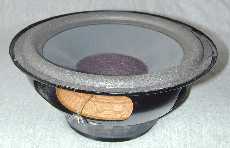
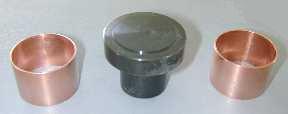 The 084 is very similar in
appearance to the 028 through 064 series. However, the magnet structure is very
different. The magnet is 30-1/2 oz. The pole piece is T-shaped to reduce flux
leakage at the top plate. In addition, a copper cylinder is located above and
below the gap and attached to the pole piece. A step is machined into the top
and underside of the T to locate the cylinders. The cylinders were painted
black in production to help dissipate heat. This lowers the distortion by a
factor of 10 over much of the woofer range. The term LD/HP refers to Low
Distortion/High Performance.
The 084 is very similar in
appearance to the 028 through 064 series. However, the magnet structure is very
different. The magnet is 30-1/2 oz. The pole piece is T-shaped to reduce flux
leakage at the top plate. In addition, a copper cylinder is located above and
below the gap and attached to the pole piece. A step is machined into the top
and underside of the T to locate the cylinders. The cylinders were painted
black in production to help dissipate heat. This lowers the distortion by a
factor of 10 over much of the woofer range. The term LD/HP refers to Low
Distortion/High Performance.
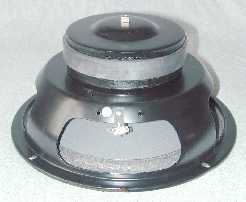 The back plate is bumped out to allow an extra long
voice coil excursion capability without bottoming. Each tinsel lead is brought
out to a terminal at opposite sides of the basket. This gives a balanced mass
on the cone and prevents instability. It also prevents the wires from touching
each other, as they need to be unusually long to allow for the extra long
excursion. A dot is placed near the positive terminal to indicate positive
polarity.
The back plate is bumped out to allow an extra long
voice coil excursion capability without bottoming. Each tinsel lead is brought
out to a terminal at opposite sides of the basket. This gives a balanced mass
on the cone and prevents instability. It also prevents the wires from touching
each other, as they need to be unusually long to allow for the extra long
excursion. A dot is placed near the positive terminal to indicate positive
polarity.
This is the first driver to incorporate the new LD/HP construction. Two of them were used in the XR250 speaker system.
![]()
12" Woofer 036-001, 032
![]()
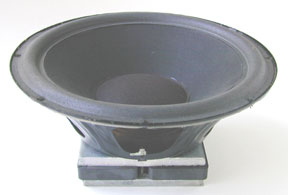 The 001 woofer was made by
United Speaker Systems to my specifications. The 032 woofer is the same as the
001 but was made by Rola-Jensen and given the new part number of 036-032. The
4-layer voice coil is 2" in diameter and wound on a black anodized
aluminum form to help dissipate heat.
The 001 woofer was made by
United Speaker Systems to my specifications. The 032 woofer is the same as the
001 but was made by Rola-Jensen and given the new part number of 036-032. The
4-layer voice coil is 2" in diameter and wound on a black anodized
aluminum form to help dissipate heat.
A high flux density is required in the gap to produce the overdamped response characteristic needed for the combination speaker/equalizer system. The square ferrite magnet weighs 54 oz. The steel top and bottom plates are 4" square and are 1/2" thick. Because the woofer must handle very high power at frequencies down to 20Hz, a long excursion capability is required. To prevent the voice coil from bottoming, a circle is machined out of the bottom plate 3/8" deep. The structure is glued together and held by screws on either side as well.
 The drivers made by United are stamped W-513. This is
a manufacturing number used to identify them. The W indicates a woofer. They
have a typical date of manufacture stamp such as MAR 4 1974.
The drivers made by United are stamped W-513. This is
a manufacturing number used to identify them. The W indicates a woofer. They
have a typical date of manufacture stamp such as MAR 4 1974.
The surround is foam. I found that treated cloth was unacceptable. At long excursions the half-roll of the cloth collapsed and made a cracking noise like a whip. Rubber surrounds add considerable mass and reduce speaker efficiency. In addition, the rubber half-roll tends to go to resonance at some frequencies. The foam had no such problems.
The cone is straight in shape. Many different kinds of cone material were available. I found that a particular stock of paper provided excellent response and maintained its shape providing very low distortion at low frequencies. Even to this day, with all new materials that have been advertised, certain paper stock is still superior in this respect.
A felt dust cap treated with a starch stiffener is located in the center. A tinsel lead is brought out to opposite sides of the basket. This gives a balanced mass on the cone and prevents instability. It also prevents the wires from touching each other, as they need to be unusually long to allow for the extra long excursion. A red dot is placed near the positive terminal to indicate polarity.
These woofers were used in the ML-1C, ML-2C, ML-2M, ML-4C and ML-4M speaker systems.
T-S Parameters
|
Mechanical Fs = 24.6 Hz |
Electrical Qes = .20 |
Combination Qts = .19 |
12" Woofer 036-047
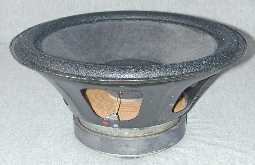 A later version of the 032 woofer was also made by
Rola-Jensen. The machined back plates and square magnets were getting more
difficult to purchase. A new overdamped woofer was designed using a commonly
available round magnet. Instead of a machined out back plate, a bumped out
plate 3/8" thick was used. The front plate remained at 1/2" thick.
The cone, voice coil, surround and spider assembly remained the same.
A later version of the 032 woofer was also made by
Rola-Jensen. The machined back plates and square magnets were getting more
difficult to purchase. A new overdamped woofer was designed using a commonly
available round magnet. Instead of a machined out back plate, a bumped out
plate 3/8" thick was used. The front plate remained at 1/2" thick.
The cone, voice coil, surround and spider assembly remained the same.
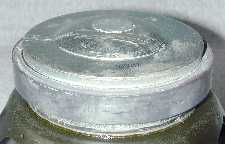 The surround is still foam but a protective coating of
diluted Airflex 400 was painted on the outside of the surround. Response is the
same as the 001 and 032 woofers.
The surround is still foam but a protective coating of
diluted Airflex 400 was painted on the outside of the surround. Response is the
same as the 001 and 032 woofers.
These woofers were used in the McIntosh XR5, XR6 and XR7 speaker systems.
|
Mechanical Fs = 22 Hz |
Electrical Qes = .16 |
Combination Qts = .15 |
![]()
6" Woofer 036-063
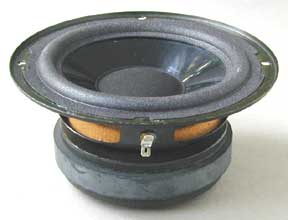 This woofer was designed and built by McIntosh. It was
used in the XL-1 system. The magnet structure is very similar to the McIntosh
made 8" drivers. The cone is polypropylene. This cone material is not
normally acceptable for woofers because it deforms at very low frequencies and
high sound pressure levels. However, the response of the XL-1 is designed to be
flat only to about 90 Hz and does not extend to the lowest frequencies.
This woofer was designed and built by McIntosh. It was
used in the XL-1 system. The magnet structure is very similar to the McIntosh
made 8" drivers. The cone is polypropylene. This cone material is not
normally acceptable for woofers because it deforms at very low frequencies and
high sound pressure levels. However, the response of the XL-1 is designed to be
flat only to about 90 Hz and does not extend to the lowest frequencies.
The voice coil leads are brought out to opposite sides of the cone to give good dynamic balance. the basket is 6-5/8" in diameter. Weight is 4.8 lbs.
![]()
12" woofer 036-067
![]()
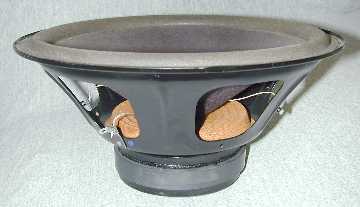 This woofer was designed and
built by McIntosh. It was used only in the XL-1W bass speaker system. The XL-1W
supplemented the XL-1 systems as a common bass speaker. To accomplish this, two
separate windings are used in
This woofer was designed and
built by McIntosh. It was used only in the XL-1W bass speaker system. The XL-1W
supplemented the XL-1 systems as a common bass speaker. To accomplish this, two
separate windings are used in 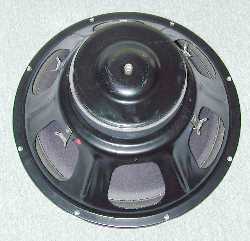 the
voice coil, one winding being connected to the left channel and the other to
the right channel.
the
voice coil, one winding being connected to the left channel and the other to
the right channel.
Each winding is 8 ohms. Each pair of tinsel leads is brought out to terminals on opposite sides of the basket to maintain a balanced mass on the cone and prevent instability. The terminals are well spaced apart to prevent the tinsel leads from touching each other when the woofer is driven at high power. Colored dots are used to identify the windings. Red and green are for one winding, red being positive. Silver (or white) and blue are used for the other, white being positive.
The 5/32" back plate is bumped out near the center to allow for the extra long excursion requirements for the 2" voice coil.
![]()
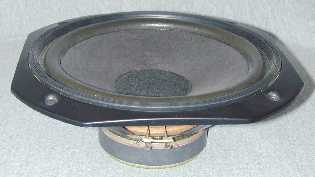 This 10" woofer is made by Cotron in Taiwan. The
decorative mounting frame is part of the stamped steel basket and is painted
black. The two voice coil leads are brought out on the same side of the cone to
a double terminal strip. A red
This 10" woofer is made by Cotron in Taiwan. The
decorative mounting frame is part of the stamped steel basket and is painted
black. The two voice coil leads are brought out on the same side of the cone to
a double terminal strip. A red 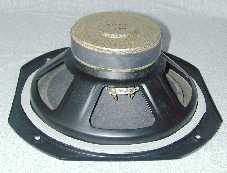 dot on the terminal
indicates polarity. The cone is paper and the surround is a urethane half roll.
A decorative plastic ring covers where the edge of the surround is glued to the
basket. This woofer is used in the XD715 and the XR230.
dot on the terminal
indicates polarity. The cone is paper and the surround is a urethane half roll.
A decorative plastic ring covers where the edge of the surround is glued to the
basket. This woofer is used in the XD715 and the XR230.
The back plate is bumped out to allow for a long excursion. Foam mounting tape is attached to the basket of the woofer before it is installed in the cabinet. This insures a good seal to the cabinet.
The outside of the basket is 12-1/4" across the diagonal. Depth behind the front plate is 4". Magnet outside diameter is 4-3/4". Weight is 5.7 lbs.
![]()
This 12" woofer is made by Cotron in Taiwan. It is similar in appearance and construction to the 10" 074 woofer. The decorative mounting frame is part of the stamped steel basket and is painted black. The two voice coil leads are brought out on the same side of the cone to a double terminal strip. The cone is paper and the surround is a urethane half roll. A decorative plastic ring covers where the edge of the surround is glued to the basket. This woofer is used in the XD717 and XR240
![]()
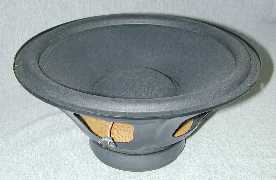 The 085 is very similar in appearance to the 036-065.
However, the magnet structure is very different. The magnet is 30-1/2 oz. The
pole piece is T-shaped to reduce flux leakage at the top plate. In addition, a
copper cylinder is located above and below the gap and attached to the pole
piece. This lowers the distortion by a factor of 10 over most of the woofer
range. See the 084 10" woofer for more information about the LD/HP
construction.
The 085 is very similar in appearance to the 036-065.
However, the magnet structure is very different. The magnet is 30-1/2 oz. The
pole piece is T-shaped to reduce flux leakage at the top plate. In addition, a
copper cylinder is located above and below the gap and attached to the pole
piece. This lowers the distortion by a factor of 10 over most of the woofer
range. See the 084 10" woofer for more information about the LD/HP
construction.
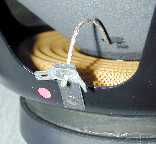 The back plate is bumped out to allow an extra long
voice coil excursion capability without bottoming. Each tinsel lead is brought
out to a terminal at opposite sides of the basket. This gives a balanced mass
on the cone and prevents instability. It also prevents the wires from touching
each other, as they need to be unusually long to allow for the extra long
excursion. The tinsel is shown looped to allow for the long cone excursion. A
dot is placed near the positive terminal to indicate positive polarity.
The back plate is bumped out to allow an extra long
voice coil excursion capability without bottoming. Each tinsel lead is brought
out to a terminal at opposite sides of the basket. This gives a balanced mass
on the cone and prevents instability. It also prevents the wires from touching
each other, as they need to be unusually long to allow for the extra long
excursion. The tinsel is shown looped to allow for the long cone excursion. A
dot is placed near the positive terminal to indicate positive polarity.
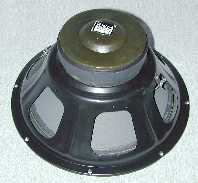 The barium ferrite magnet weighs 30-1/2 ounces. The
4-layer voice coil is 2" in diameter and wound on a black anodized
aluminum form to help dissipate heat. The top plate is 1/2" thick. The
back plate is bumped out to allow for the long excur4sion of the voice coil.
The efficiency of the magnet structure is improved. Use of a T-shaped pole
piece makes the flux path outside the gap more symmetrical by reducing leakage
from the front plate to the pole piece, which then increases the flux in the
gap.
The barium ferrite magnet weighs 30-1/2 ounces. The
4-layer voice coil is 2" in diameter and wound on a black anodized
aluminum form to help dissipate heat. The top plate is 1/2" thick. The
back plate is bumped out to allow for the long excur4sion of the voice coil.
The efficiency of the magnet structure is improved. Use of a T-shaped pole
piece makes the flux path outside the gap more symmetrical by reducing leakage
from the front plate to the pole piece, which then increases the flux in the
gap.
![]()
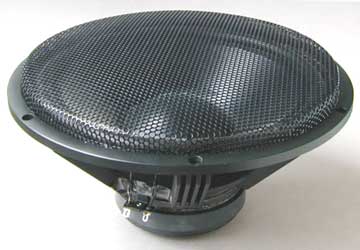 This woofer was designed and built at McIntosh. It has
one of the new McIntosh cast baskets. It is used in the McIntosh HT-2 subwoofer
system. The system has two of these woofers and they are mounted facing
downwards. Because no grille is used underneath the enclosure, a protective
perforated metal grille is fitted in front of the cone to protect it.
This woofer was designed and built at McIntosh. It has
one of the new McIntosh cast baskets. It is used in the McIntosh HT-2 subwoofer
system. The system has two of these woofers and they are mounted facing
downwards. Because no grille is used underneath the enclosure, a protective
perforated metal grille is fitted in front of the cone to protect it.
A white dot indicates the positive terminal.
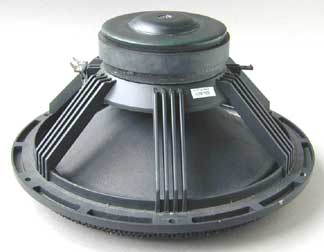 Although the cast baskets are made to accommodate
terminal connections on opposing sides of the basket, for some reason, after I
left McIntosh, this valuable feature was discontinued. The arrangement, used in
previous woofers, is intended to give good dynamic balance for the moving mass
and avoids short circuits for the tinsel leads.
Although the cast baskets are made to accommodate
terminal connections on opposing sides of the basket, for some reason, after I
left McIntosh, this valuable feature was discontinued. The arrangement, used in
previous woofers, is intended to give good dynamic balance for the moving mass
and avoids short circuits for the tinsel leads.
The picture below shows the result. I found this woofer from a used HT-2 speaker system. Several mistakes are apparent. Both voice coil leads have been brought out to a single insulated dual terminal. The connections are far from where the tinsel leads exit from the cone. The result is that the excessively long leads can touch each other and short circuit at high power levels when the leads go into various gyrations. In addition, the leads can also easily touch the metal basket and again there is a possibility of a short circuit.
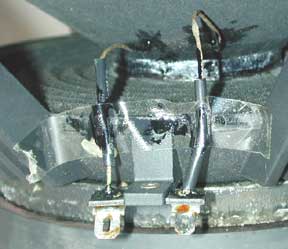 As you can see, someone has put insulation around the
tinsel next to the terminals to prevent shorting to the basket but this wasn't
enough to prevent the leads from touching each other. Transparent tape is used
to hold the insulation in place. Remember, the woofers are used facing down and
the tape also prevents the little pieces of insulation from slipping away from
the terminals.
As you can see, someone has put insulation around the
tinsel next to the terminals to prevent shorting to the basket but this wasn't
enough to prevent the leads from touching each other. Transparent tape is used
to hold the insulation in place. Remember, the woofers are used facing down and
the tape also prevents the little pieces of insulation from slipping away from
the terminals.
A simple solution would have been to use my original design having a single terminal on each side of the basket that extends the connection higher and closer to the cone. This would have allowed the leads to be shorter and avoid touching each other or touching the basket. It would also eliminate the possibility of the leads hitting the cone.
![]()
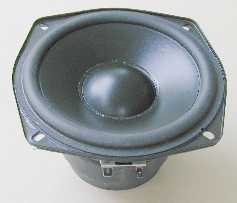 This 5" driver is made by Tonegen in Japan. It has
a polypropylene cone and a rubber surround. A hard plastic dust cover is in the
center. Impedance is 4 ohms. This driver along with the 036-122 tweeter was
used in the DDS-01 Karaoke speaker system made for sale in Japan. It is a
two-way system.
This 5" driver is made by Tonegen in Japan. It has
a polypropylene cone and a rubber surround. A hard plastic dust cover is in the
center. Impedance is 4 ohms. This driver along with the 036-122 tweeter was
used in the DDS-01 Karaoke speaker system made for sale in Japan. It is a
two-way system.
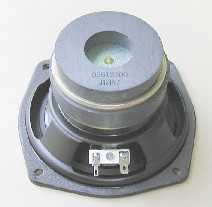 This driver has magnetic shielding. It is in the form
of a reverse polarized magnet that is attached to back plate of the magnetic
structure. It effectively reduces the stray magnetic field so the speaker can
be placed near a TV set without affecting the picture or color. The reverse
magnet is not as large as the main magnet.
This driver has magnetic shielding. It is in the form
of a reverse polarized magnet that is attached to back plate of the magnetic
structure. It effectively reduces the stray magnetic field so the speaker can
be placed near a TV set without affecting the picture or color. The reverse
magnet is not as large as the main magnet.
The basket diameter is 5-5/16" from side to side. The depth behind the mounting surface is 2-7/8". A foam gasket is attached behind the rim of the basket to form a seal when the driver is mounted in the cabinet. Voice coil diameter is 1" Weight is 1016 grams or about 2.2 lbs.
![]()
![]()
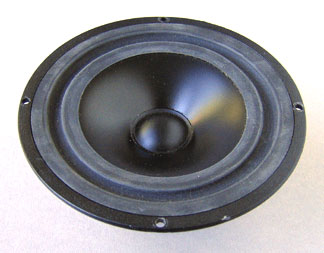 This driver is made by Seas and is the same as the
Seas P17RC. However, a a reverse polarized magnet was glued to back plate of
the magnetic structure for McIntosh. It effectively reduces the stray magnetic
field so the speaker can be placed near a TV set without affecting the picture
or color. The reverse magnet is not as large as the main magnet. The Seas part
number for McIntosh was changed to P17RCD.
This driver is made by Seas and is the same as the
Seas P17RC. However, a a reverse polarized magnet was glued to back plate of
the magnetic structure for McIntosh. It effectively reduces the stray magnetic
field so the speaker can be placed near a TV set without affecting the picture
or color. The reverse magnet is not as large as the main magnet. The Seas part
number for McIntosh was changed to P17RCD.
It has a polypropylene cone and an inverted
rubber roll surround. A soft PVC plastic dust cover is in the center. Impedance
is 8 ohms. The basket is 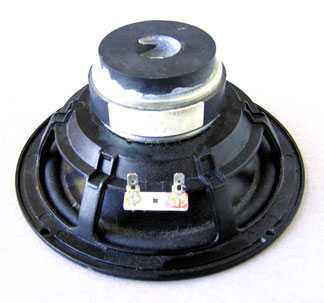 made of cast metal.
made of cast metal.
The basket diameter is 6-1/2" from side to side. The effective cone diameter is 5”. The depth behind the mounting surface is 3". Voice coil diameter is 1" and weight is 850 grams or about 1.9 lbs.
|
About This Site |
||
|
|
More text and pictures about McIntosh will be added as my research continues. Any comments, corrections, or additions are welcome. |
|
|
|
|
Created
by Roger Russell |